Servicios Personalizados
Revista
Articulo
Indicadores
-
 Citado por SciELO
Citado por SciELO -
 Accesos
Accesos
Links relacionados
-
 Citado por Google
Citado por Google -
 Similares en
SciELO
Similares en
SciELO -
 Similares en Google
Similares en Google
Compartir
Signo y Pensamiento
versión impresa ISSN 0120-4823
Signo pensam. v.31 n.60 Bogotá ene./jun. 2012
Communicative Citizenship, Preliminary Approaches
La ciudadanía comunicativa, aproximaciones preliminares
CAMILO ANDRÉS TAMAYO GÓMEZ *
* Camilo Andrés Tamayo Gómez. Colombiano. Comunicador Social de la Pontificia Universidad Javeriana de Colombia. Estudios de Filosofía Política en la Universidad de Oxford (Reino Unido) y de Sociología en la Universidad Nacional de Colombia. Master meritorio en Ciudadanías Globales, Identidades y Derechos Humanos por la Universidad de Nottingham (Reino Unido). Estudiante del Doctorado en Política y Estudios Internacionales de la Universidad de Huddersfield (Reino Unido) y Experto Asociado al Centro Regional para América Latina y El Caribe del Programa de Naciones Unidas para el Desarrollo - PNUD. Diez años de experiencia investigativa y docente en temas de comunicación, ciudadanía, desarrollo, democracia y derechos humanos en América Latina y El Caribe. Autor y coautor de varios libros, como Lo que le vamos quitando a la guerra: medios ciudadanos en contextos de conflicto armado en Colombia (2008), Hacer real lo virtual: discursos del desarrollo, tecnologías e historia del Internet en Colombia (2008) y Mutaciones contemporáneas: medios de comunicación y proceso electoral en Colombia 2006 (2007), entre otros. Correo electrónico: camilotamayogomez@gmail.com
Submission Date: July 5th, 2011 Acceptance Date: September 6th, 2011
Recibido: Julio 5 de 2011 Aceptado: Septiembre 6 de 2011
In order to understand the relationship between communication, citizenship and rights it is necessary to analyse three fields separately: the political communication field, the social communication field and the cultural communication field. This research has developed a concept of communicative citizenship, a model and methodological tools to create a comprehensive and integrative approach to the relationship between communication, citizenship and rights, and overcome this gap. The project includes the analysis of socio communicative regimes in an armed conflict context (Colombia), a multicultural context focusing on migrants' political action (United Kingdom), and a society where Governmental control affects communicative and political rights (Italy). To describe, analyse and understand how these conditions affect the human rights field and how it is possible to claim for justice, equality and freedom from a communicative perspective, are the final aims of this research.
Keywords: Communicative Citizenship, Human Rights, Citizenship, Democracy, Public Sphere, Communicative Regime.
Search Tags: Human rights, Social Communication, Communication in politics, Communication and culture, Citizenship - social aspects, Social change.
Para entender la relación entre comunicación, ciudadanía y derechos es necesario analizar por separado tres campos de la comunicación: el político, el social y el cultural. La investigación que se presenta en este artículo busca desarrollar un nuevo concepto de ciudadanía comunicativa, un modelo y unas herramientas metodológicas que permitan abordar de manera comprehensiva e integradora la relación entre comunicación, ciudadanía y derechos. El proyecto contempla el análisis de los regímenes socio-comunicativos en un contexto de conflicto armado (Colombia), en un contexto multicultural enfocado hacia la acción política de los migrantes (Reino Unido), y en una sociedad donde el control político gubernamental afecta los derechos políticos y de expresión (Italia). El objetivo es describir, analizar y explicar cómo estas condiciones afectan los derechos humanos en estos países y cómo se puede exigir justicia, igualdad y libertad desde una perspectiva de la comunicación.
Palabras clave: Ciudadanías Comunicativas, Derechos Humanos, Ciudadanía, Democracia, Esfera Pública, Régimen Comunicativo.
Descriptores: Derechos humanos, comunicación social, comunicación en política, comunicación y cultura, ciudadanía - aspectos sociales, cambio social.
Origen del artículo
Esta investigación es un proyecto que comenzó en la Universidad de Nottingham, Reino Unido, en el 2009, bajo la supervisión del Dr. Nick Stevenson. En el 2011, la Universidad de Huddersfield (Reino Unido) acogió este proyecto para desarrollar una ajuste teórico más preciso y pertinente y proponer estudios comparados sobre la temática. Este artículo presenta brevemente algunas de las construcciones teóricas realizadas hasta el momento.
Introduction
Currently, in order to understand the relationship between communication, citizenship and rights it is necessary to analyze three fields separately: the political communication field, the social communication field and the cultural communication field. The boundaries of these fields are not static, they are very dynamic, it is possible to find intersections between them, and reflections on citizenship are very common in these studies; especially to try to understand what kind of new responsibilities and rights do citizens in Western societies have when new social conditions appear (Globalization, Information Age, Neo-Liberalism), how these new conditions affect, transform and change the sense of "citizenship" itself, and what kind of new communicative regime emerge (Curran 1997; Todorov 1999 ; McNair 1999 ;Curran and Morley 2006 ; Castells 2006; Rey 2007; Mcloughlin & Scott 2010).
However, social researchers only developed specific approaches to these fields separately and it is possible to find well-developed research, reflections, debates and arguments in these fields. In other words, it is possible to find an "academic tradition" for these issues in contemporary studies, but there is a lack of comprehensive and integrative approaches. In a nutshell, it is possible to independently understand the characteristics of the communicative regime in terms of political, cultural and social dimensions, but always unconnectedly. This situation has five implications: irstly, it is not possible to understand in holistic terms, the relationship between communication, citizenship and rights; secondly, explanations of communicative regime are limited to speciic ields and usually in instrumental terms; thirdly, a lack of information about causes and consequences of contemporary social communicative transformations; fourthly, deicient connections and links in order to understand the conformation of public spheres in Western societies; and finally, limitations to the comprehension, analysis and research of socio-communicative ield in society and its links with contemporary social science studies.
In this context, this paper will try to present the theoretical frame of the research "Communicative citizenship, another dimension of rights" (supported by the University of Huddersfield) that developed a concept of "communicative citizenship", a model and methodological tools, to create a comprehensive and integrative approach to the relationship between communication, citizenship and rights, and overcome this gap.
There are four principal aims of this research: firstly, to define the concept of communicative citizenship and to create linkages with the communicative dimensions of social, cultural and political rights; secondly, to build a map to understand this model and the relationship between communication, democracy and rights; thirdly, to develop a methodological box to produce different indicators for use in case studies, especially to understand the communicative regimes in different contexts; and finally, to generate empirical and qualitative data to compare categories and results. The principal objective of this research is to give provisional answers to the following question: Could the concept of communicative citizenship provide a new approach to integrate all the communicative dimensions of cultural, political and social rights and help to develop better democratic public spheres in Western societies?
Moreover, this research has five important significances: first, to overcome the traditionally instrumental consideration of the relation between communication and citizenship; second, to explore other dimensions of citizenship in the information age and the globalization process; thirdly, to begin to create methodological tools to analyze the different communicative regimes in Western societies; fourthly, to generate empirical and comprehensive data to understand contemporary communicative regimes; and finally, to contribute to the academic relationship between sociology, communication and politics and their implications for the democracy in the long term.
Once again, this paper will focus on the theoretical approach of this research in order to show contemporary ways to understand the communicative citizenship concept and the relationship of this new categorywith other social science fields.
Citizenship and communication, exploring the jigsaw
In the last two decades scholars from disciplines like sociology, media studies, political science, communication and political philosophy have been developing different approaches to explore the relationship between citizenship and communication and the role of these two categories in society. Following scholars like Curran (1997), Todorov (1999), McNair (1999),Curran and Morley (2006), Castells (2006), Rey (2007) and Mcloughlin & Scott (2010) it can be concluded that this relationship is inherent, structural, indivisible and essential. Now these two categories are in total redefinition and reconstruction, because geopolitical and socio-cultural changes have affected the conventional meaning of these concepts, precipitated by the globalization process, the crisis of the nation — state, the network society and the crisis of the modernity project.
However, social researchers have developed various studies in this field and it is possible to find well-developed research, reflections and debates in different academic fields, in other words, an academic tradition exists for this issue in contemporary social studies. There is, however, a lack of integrative approaches. Following this academic discussion, and the principal arguments of this theoretical field, I am going to establish five contemporary interconnections between the categories of citizenship and communication in the hope of building a more comprehensive idea of the importance of this relationship to understand the dynamic of the actual social structure.
These contemporary interconnections are: firstly, the homogenizing function of citizenship in developing senses of belonging and loyalty to a particular society and territory has changed,and now both communication and citizenship have new meanings in social spaces that provide people with a sense of political and cultural belonging, transforming social structures, roles and public responsibilities in the social arena. Secondly, the key role of citizenship and communication in the formation of democratic public spheres has been revitalized because values of equality, diversity, respect, solidarity and freedom have been expressed through different kinds of social and media narratives, affecting mentalities and representations of liberal ideas in public opinion.
Thirdly, the tie between citizenship and the main characteristics of a democratic regime (constitutionality, participation and rational choice) are now affected by the symbolic centrality of the new technologies of communication and information, allowing citizens to take a more active role in the public sphere. Now the citizen has more communicative resources with which to receive quality information about public issues, and has different channels to express diverse points of view in the public sphere. In the same way, this new communicative context helps scholars to once again reconsider different perspectives of the "ideal concept" of the public sphere in liberal democracies (e.g. ideal concept from Habermas, Mouffe, Touraine) and how it is possible to build a strong civil society that demands respect of universal human rights principles.
Fourthly, the urgent need for a new set of rights, especially communicative rights, emerged as a consequence of the tension between communication and citizenship, because the new socio-communicative regime provides other ways of understanding the role of communication in the public sphere and how this new role transforms the traditional meanings of concepts such as democracy, representation, rights, duties, responsibilities and participation in contemporary social structures. Finally, the relationship between citizenship and communication can be used to try and develop a more democratic media system, and this new socio-communicative regime would highlight the central role of communication in contemporary society.
These interconnections incorporate the ideas of scholars like Curran (1997), Todorov (1999), McNair (1999), Stevenson (2003), Castells (2006), Curran & Morley (2006), Rey (2007) and Mclough-lin & Scott (2010), and are the principal resource that I will use to develop the category of communicative citizenship. However, before explaining the concept and model of communicative citizenship in this paper, it is necessary to first focus on two central theoretical aspects: firstly, to understand the reconfigurations of the category of citizenship and its links with other social categories; and secondly, to analyze the intersections between the communicative dimensions of political, social and cultural rights and the new meanings of citizenship, in order to then explore what set of new rights and duties will emerge in this new context.
First piece: understanding citizenship challenges
Taking a traditional approach, Charles Tilly defines citizenship as a tie or special sort of contract (Tilly 1995) and provides the next definition of citizenship:
"A continuing series of transactions between persons and agents of a given state in which each has enforceable rights and obligations uniquely by virtue of (1) the person's membership in a exclusive category, the native — born plus the naturalized and (2) the agent's relation to the state rather than any other authority the agent may enjoy" (Tilly 1995, p.8).
Stevenson (2003) argues that the category of citizenship is "more often thought to be about membership, belonging, rights and obligations. In institutional terms the terrain of citizenship is usually marked out by abstract legal definitions as to who is to be included and excluded from the political community" (Stevenson 2003, p. 4), in other words, "The state demands loyalty from the individual, and in return, the individual could expect duty of care and protection from the state. This conception of citizenship (...) prioritizes political belonging" (Yip 2008, p. 102). However, writers like Castells (1997; 2006), Bauman (1998; 2007), Beck (2000; 2002), Plummer (2003), Stevenson (2002; 2003), Croucher (2004), Held (2004), Hermes (2006),Sassen (2007), andVertovec (2009) share the view that the traditional concept of citizenship is in crisis, reconfiguration, threat or reconceptualization, because new social characteristics, in particular migration flows, transnational practices and the crisis of the Neoliberal agenda, have affected the original homogenous meaning of citizenship and its link with the nation - state.
Beck (2002) considers that "the nation-state is transforming into a type of political organization or apparatus involving more multiple and overlapping jurisdictions, set of identities and social orders no longer really contained by borders" (Beck 2002, p. 67), and that the traditional function of the nation — state to define a sense of belonging with one territory, in part for its political and symbolical centrality, is now in dispute with different forms of social and citizen experience. In the same way, Croucher (2004) argues that "a declining role of relevance of the state is considered an indicator, or part and parcel, of the globalization process itself (...) emerging forms of belonging and citizenship connected from more familiar attachments to identities or individual experiences" (Croucher 2004, p.36), encouraging a consideration of another way to think about the relationship between nation-state and citizenship.As a result of the changes mentioned above, it is now possible to find other types of citizenship experience, identifications and citizenship dimensions, creating linkages with other social experiences, transnational practices, information flows, political identities and subjective recognitions.
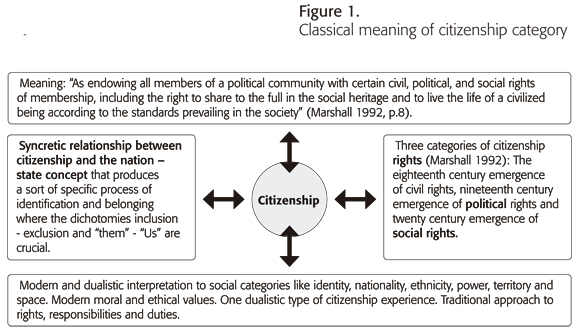
Terms such as "global citizenship" (Falk 1994), "media citizenship" (Castells 1997), "cultural citizenship" (Stevenson 2003), "intimate citizenship" (Plummer 2003), "cosmopolitan citizenship" (Held 2004), "ecological citizenship" (Dobson 2004) or "transnational citizenship" (Vertovec 2009) are some examples of these new forms of individual and collective citizenship experiences, where a new set of rights, duties and responsibilities have emerged that also link to other dimensions of citizenship. At the same time, phenomena like migration, new technologies of communication and information and transnational experiences have an enormous responsibility in the creation of these new social categories.
If in the last decades the category of citizenship has focused on creating a bond with civil, political, social and cultural rights, it is now necessary to consider another set of rights and duties to understand the development of the actual social structures and the new communicative regime around them. Stevenson (2003) argues that "the development of new conflicts, networks, cultures of risk and reflexivity, globalization and com-modification have transformed the operation of citizenship" (Stevenson 2003, p. 33) and, definitely, these contemporary citizenship transformations need, at the same time, to ask what consequences these operations have in categories such as power, mobility, identity, ethnicity and in social processes like the formation of civil spaces of participation, the construction of public spheres, or the reconfigurations of the traditional shapes of public opinion.
My main argument is that there is an urgent need to create a new concept or category to develop another approach to the rights, responsibilities and duties in connection with this new set of citizenship experiences, especially from the communication field, that affect other social categories like identity, ethnicity and power as well. If the category of citizenship is now in "crisis" it is necessary to explore other social categories in order to understand other social processes where the base is this category in itself (Bauman 1998; Castells 2006; Vertovec 2009), focusing on how a new set of rights, responsibilities and duties start to emerge in the public sphere.
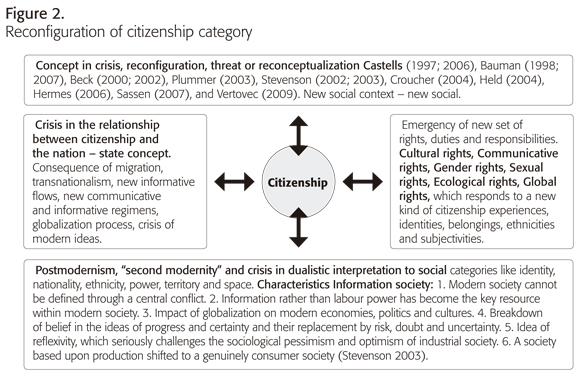
To conclude this part, it is necessary to make three final assertions. Firstly, is clear that the new communicative and informative global context has helped to change traditional social categories and processes (like citizenship and identity formations for example), and now questions about other dimensions of citizenship, and what kind of new rights, responsibilities and duties will emerge in this context is the key to understanding the transformations of the contemporary social structure. Secondly, asking how different public spheres are formed, the new role of citizens in this process, and what actions the media, the State, the market and civil society have to develop in order to democratize and diversify this field, is important in order to understand the contemporary tensions between power, diversity, rights, democracy and freedom in a communicative approach. Finally, questioning what new responsibilities citizens and civil society have in this new context to claim a more inclusionary, equal, democratic and diverse public sphere and what type of action it is now necessary to take to start the creation of a "robust civil society" (Stevenson 2003), an "active civil society" (Rey 2007), or start a real process of "civil solidarity" (Alexander 2008), could be the right approach in order to understand what the meaning of being a communicative citizen is in the information society.
Second piece: The relationship between citizenship and the communicative dimensions of political, social and cultural rights
In the historical development of civil, political and social rights Marshall (1992) drew attention to, in Stevenson's words, "the contradiction between the formation of capitalism and class, and the principle of equality enshrined within the granting of basic rights" and perceived that "the principle of civil and political rights had been granted in the eighteenth and nineteenth centuries, whereas the twentieth century had seen the acceptance of the idea of social rights" (Stevenson 2003, p.6). Furthermore, in the relationship between citizenship and this set of civil, political, social and cultural rights it is usual to ind a different dimension in connection with various communicative issues, where the boundaries of these ields are not static, but are very dynamic, and it is common to ind intersections between them.
Following scholars such as Bennet & Entman (2001), Couldry & Curran (2003), Bonilla (2004), Voltmer (2006) and Curran, Iyengar, Anker, & Inka (2009) it is possible to establish the next eight communicative dimensions in civil and political rights that form the political communication field: the mediatisation of politics, the role of the mass media in Western democracies, the development of the public sphere, the responsibilities of mass media in times of elections, political marketing, public opinion makers, the relationship between governance and media and the access to governmental information and data for citizens. As a consequence, the political rights of freedom of speech and expression have a strong link to communicative values, opening the door to reconsider questions like the role of the mass media in democratic countries and how the communicative process can help to develop better democratic public spheres as well.
In this context, scholars like McNair (1999) argue that the functions of communication media in "ideal — type" democratic societies are fivefold: firstly, they must inform citizens of what is happening around them; secondly, they must educate as to the meaning and significance of the "facts"; thirdly, the media must provide a platform for public political discourse, facilitating the formation of public opinion, and feeding that opinion back to the public from whence it came. This must include the provision of space for the expression of dissent, without which the notion of democratic consensus would be meaningless. Fourthly, to give publicity to governmental and political institutions (the "watchdog" role of journalism); and finally, as a channel for the advocacy of political viewpoints (McNair 1999, pp. 21 — 22).
In the same way, Bonilla (2004) has argued that contemporary mass media "are central arenas for competition and symbolic power display, where political and social antagonists struggle for access to the public sphere" (Bonilla 2004, p. 113), and Medina and Garcia (2001) argue that the public sphere, which includes mass media, "is a permanently tense space in constant dispute when journalists and media establish cooperation, consensus, censorship, inequality, rupture, opposition and/or autonomous relationships with other communication agents - groups and institutions to access to symbolic power in society" (Medina & Garcia 2001, p. 25). Moreover, the creation of this new "mediatised agora" (Bonilla 2004), as space for thinking about the reconfiguration of new societies and how values like diversity, respect of difference and inclusion in western democracies now operate, shows the importance of social cohesion in the social structure and how mass media affects the meanings of all them.
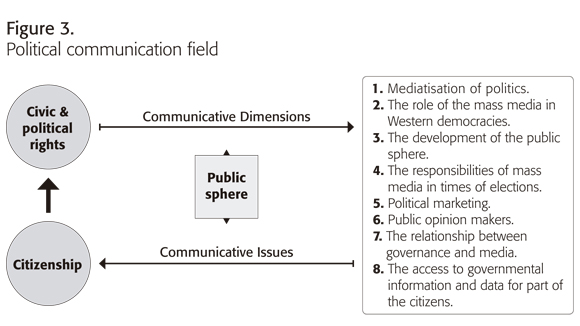
To sum up this part, it is important to express that these civil rights such as freedom of expression, press freedom and freedom of speech have a direct relationship with the formation of democratic public spheres, and some scholars like McNair (1999), Curran (2005) and Rey (2007) have established a reciprocity between the development of democracy and the formation of plural, equal and diverse public spheres in democratic countries. Besides, political rights like freedom of association and participation in civil society and politics have important connections with communicative dimensions as well, because the public exercise of these rights is a "communicative exercise" at the same time (Rey 2007), where people become visible in the public sphere sharing meanings, discourses, narratives and points of view, developing different senses of symbolical, political and communicative belonging with their communities as well.
Equally important, in the relationship between social rights and communicative dimensions that forms the social communication field, it is common to find debates and arguments focusing on discussions of freedom of speech and freedom of expression in relation to social rights, communication for development, citizen and public media, the role of NGOs in public spheres, and the responsibilities of social civility to guarantee social rights and development in society (Beatson & Cripps 2000; Klang & Murray 2005; Barendt 2005; Gumucio-Dagron & Tufte 2006 and McPhail 2009). In this respect, efforts like the Communication Rights in the Information Society — CRIS — Campaign (2005), provides an interesting approach to this relationship between communication and social rights, developing four pillars of social communication rights: firstly, Communicating in the Public Sphere, where analyzing the role of communication and media in exercising democratic political participation in society is the main issue; secondly, Communication Knowledge, the terms and means by which knowledge generated by society is communicated, or blocked, for use by different groups; thirdly, Civil Rights in Communication, the exercise of civil rights relating to the process of communication in society; and finally, Cultural Rights in Communication, where the communication of diverse cultures, cultural forms and identities at the individual and social levels are the principal issues (Siochrú 2005).
To understand the global meaning of these rights scholars like Siochrú express that:
"Each Pillar of Communication Rights relates to a different domain of social existence, experience and practice, in which communication is a core activity and performs key functions. The rational for the four pillars is, that each involves a relatively autonomous sphere of social action, yet depends on the others for achieving its ultimate goal - they are necessary interlocking blocks in the struggle to achieve communication rights. Action can be coherently pursued under, each, often in collaboration with other social actors concerned with the area more generally; while bridges can and must be built to the other areas if the goal is to be achieved" (Siochru 2005, p. 39).
Similarly, the social communication field describes the relevance of citizens' media in the communicative ecosystem, a type of media that implies "a collective embracing of new media and interaction, in a way that contests social codes, legitimized identities and institutionalized social relations, through a means of empowering the community" (Meikle 2004, p. 78), where media users (citizens) have become media producers (social action), attempting through this to change information and communication equality through participatory democracy. The relevance of defending social rights in public spheres and claiming diversity and equality in mass media, especially in terms of resources, narratives and access, the significance of cultural transformations in society and how these changes affect communicative relations of meanings, narratives, discourses and symbolic regimen, are other important issues within this field.
In this context, my main argument is that civil society is one of the principal social actors that has to develop a new type of socio-commu-nicative regime, demanding in different spaces, fields or " socio-political arenas" the recognition of communicative social rights as citizen rights, and start a process of communicative democratization where citizen counter hegemony power and action are one of the principal resources. As result, the category of power is central in this debate, and understanding citizenship as a continuing process, and not as something static or inherited (Mouffe 1992), is one of the final aims in this challenge.
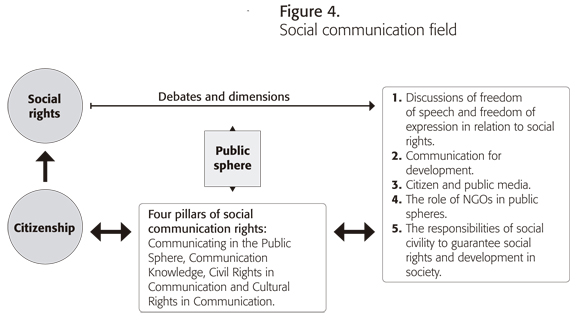
Finally, following scholars like Martin-Barbero (1993), Wolfsfeld (1997), Stevenson (2002; 2003), Castells (2006), Curran & Morley (2006) and Hesmondhalgh & Toynbee (2008) it is possible to establish the next seven debates in the relationship between cultural rights and communicative dimensions, that forms the cultural communication field: the role of the mass media in the creation of inclusionary and plural narratives, the visibility and representation of equality resources in the media agenda, the role of communication in cultural processes, the relationship between media, citizenship and cultural power, globalization and the impact of technocultures, the uses of communication as part of civil society and social action, and how culture affects communication and vice versa.
One aspect of that field paid particular attention is the relationship between inclusion and construction of public space, because the possibility of achieving a genuinely participative and educative democracy rests upon building an inclusive civil society taking a cultural approach, in Stevenson's (2003) words:
"We need to rethink our ideas in respect of social democracy and liberalism, we also need to address the "cultural dimension" of citizenship. The emergence of new social movements and critical questions that can be related to "identity" politics has been crucial in this respect. Social movements in respect of race and ethnicity, gender and sexuality, disability and others have all sought to interrupt the construction of dominant cultures. These movements look the challenge widely held stereotypes that once permeated the symbolic cultures of civil society. The deconstruction of ideas that have been associated with the "normal" citizen has attempted to widen the "inclusive" fabric of the community, while creating space for difference and otherness. Questions of "cultural" citizenship therefore seek to rework images, assumptions and representations that are seen to be exclusive as well as marginalizing. At heart, then, these dimensions ask: how might we build an inclusive society? Crucial in this respect is how we imagine and construct public space" (Stevenson 2003, p.18).
Once again, is important to say that the boundaries of the communicative dimension of political, cultural and social rights are interconnected and related (Rey 2007) and it is usual to find similar questions with different approaches or relevancies. This is important in order to express that the necessity of establishing an inclusionary public space, a diverse, equal and participative public sphere and a strong civil society, are the main nature of the relationship between communication and rights. Moreover, the central role of the mass media in the deconstruction of public and private spaces and how global media transforms cultural meanings in society, especially in representations, stereotypes and global values through narratives and discourses, are other central topics in the cultural communication field. In this context, scholars like Martin-Barbero (1993) argue that the mass media have a particular role in the creation of national narratives and, in some contexts, the tension between hegemonic cultural discourses and diversity of cultural practices affects the revalidation of cultural rights in the public sphere (Martin-Barbero 1993, p. 45).
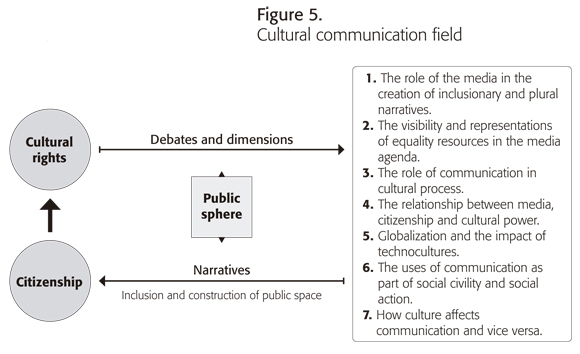
To sum up this part, it is necessary to make three assertions. Firstly, the contemporary centrality of global media in providing different narratives to more complex audiences, opens the door to rethink issues like identity, cultural rights, appropriation and cultural consumption in a more connected / disconnected world (Castells 2006), providing interconnected relations between local, national and global public spheres and cultural rights in different scales as well. Secondly, the emerging role of a media literacy (Mcloughlin & Scott 2010) to provide citizens with skills to access, analyze, evaluate and create media content, could be the answer to configure a stronger tie between cultural rights and inclusion in public spheres; and finally, the development of a new set of cultural policies where the respect of difference and the recognition of cultural diversity are essential issues, could be an opportunity to establish cultural centrality in the citizen rights field.
Exploring the communicative citizenship field
"Nothing is more practical than a good theory".
Jeffrey Alexander
Following the five interconnections between communication and citizenship described previously in this paper, I am going to develop the next three steps: firstly, the creation of the category of communicative citizenship and what dimensions this new concept contains; secondly, a description of the communicative citizenship model, including the provision of information as to how this category operates in the public spheres and what aims and goals follow, in connection with the role of civil society in these fields. Finally, it will explain the "methodological box", a methodological tool to explore how this category could be analyzed and find trends of communicative citizenship in different contexts.
Three considerations will shape this theoretical exercise: firstly, this effort tries to go beyond the instrumental, parochial, relativist or mediacentric perspective that the social sciences traditionally use to comprehend the communicative field and its relation with other fields such as political, cultural or social (Hesmondhalgh & Toynbee 2008); secondly, this communicative citizenship concept aims to create a tie between communication and citizenship that crosses the disciplinary borders of social, political and communication theory, cultural and media studies, and describes the communicative regimes on different scales: global, regional, national or local. Moreover, this approach is always interconnected with the role of civil society and citizens in the construction of more democratic public spheres. Finally, this concept comes from a civil society perspective, and tries to provide more tools to build the utopian process of civil solidarity (Alexander 2006) that understands the civil sphere as a project, and where the formation of a strong civil society in public spheres could be the key to create a more free and equal world with real possibilities of justice.
Communicative citizenship concept
Following the communicative dimension of civil, political, social and cultural rights and the five contemporary interconnections between the categories of citizenship and communication described previously in this paper, I hope to have conveyed that communicative citizenship is an interdisciplinary concept that is concerned with the values of equality, solidarity, access to technology, respect of difference, participation, recognition, justice, information, knowledge and quality of life within a global arena.
This concept represents the instrumentalization of a new dimension of citizenship where communicative action is at the centre of the social dynamic, and one of its primary purposes is to understand the different communicative manifestations, actions, strategies and tactics associated with the contemporary struggle for recognition, meaning and significance for different actors in public spheres.
Furthermore, communicative citizenship can become a concept which is used to claim equal representations and plural narratives in the mass media, access to governmental information and data, guarantee of freedom of speech and expression, to promote the use of communication and information for governance and development, to generate participatory communicative practices in public spheres and to encourage diversity within the mass media ecosystem.The citizen, civil society and the civil sphere are at the centre of the dynamic that emerges from the instrumentaliza-tion of the concept of communicative citizenship, and provides communicative agency to citizens in order to transform different social structures.
One of the more important discussions before in this paper was what new form of individual and collective citizenship experience could emerge in connection to other dimensions of citizenship, and what set of rights, duties and responsibilities it is possible to now establish. The next figure describes the relationship between communicative citizenship dimensions and the set of rights that emerge in this context.
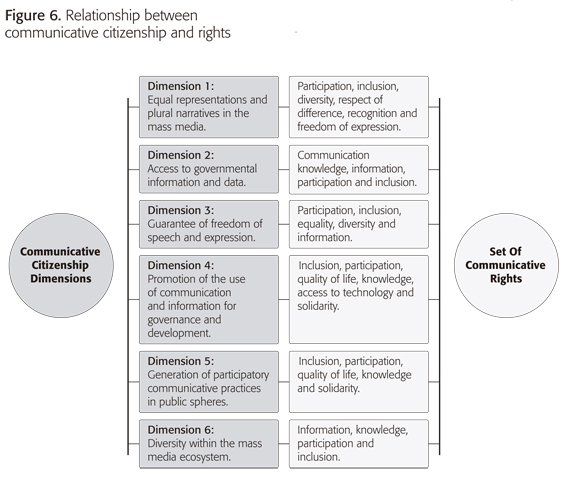
As figure 6 shows, there are six communicative citizenship dimensions which link to a different set of communicative rights that come from communicative dimensions of civil, political, cultural and social rights. These six dimensions have a direct relation with rights and demands, because in this aspect the communicative citizenship concept tries to encourage the development of communicative agency in citizens. If by agency we understand "the ability to be able to act within a social and cultural context while making a difference to the flow of events. Agency should not be thought of as the opposite of structure, but dependent upon rules and resources generated by social structures. To have agency is defined by the ability to be able to intervene actively" (Stevenson 2003, p. 155), these linkages provide the different aims to achieve in the social structure, through citizen action.
The first dimension, equal representations and plural narratives in the mass media, refers to the possibility of claiming more diverse points of view in the narratives of mass media, especially in news and informative narratives. This dimension has a strong link to journalism practices and it is the social responsibility of mass media to provide information using different types of resources in order to describe the complexity of social reality. The access of audiences to different points of view about social issues improves the quality of public spheres, because this diversity encourages the recognition of other social actors and their demands. The rights of participation and inclusion have an important role here, and this plurality represents the first step in demanding another symbolic regime, where the equal access to other social perspectives and values could transform power relations in social structures. If multiculturalism seeks to understand how different cultures might best live together (Stevenson 2003), the aim of this dimension is to transform the mass media in plural spaces where different cultures and social actors can interact in equal conditions, and freely express arguments and reasons in the "mediatised agora" (Bonilla 2004), creating inclusive media spheres. Furthermore, the category of power is a central issue in this dimension and has an important connection to the creation of mentalities and representations in public opinion.
The second dimension, access to governmental information and data, is crucial for "enabling citizens to exercise their voice, to effectively monitor and hold government to account, and to enter into formed dialogue about decisions which affect their lives" (Mcloughlin & Scott 2010, p. 29), and has a strong tie with the relationship between communications and governance. This dimension provides citizens with the ability to use information to contribute to governmental transparency and demand better governance and public services. The right to information is a central right here, establishing participation in governance for parts of civil society, and promoting equal economic development, reducing poverty and fighting corruption. At the same time, this dimension is connected with the right of communication knowledge described previously in this paper, and tries to support governmental action in favour of participation and inclusion, stimulating the capacity of public bodies to provide information in public spheres. The British national data website (data.gov.uk), The United States Open Governmental Data Project (data.gov), The City of Toronto's official Data Set Catalogue (toronto.ca/open) and The New Zealand Open Data Catalogue (open.org.nz), are some examples of the instrumentaliza-tion of this dimension in specific contexts, using a semantic web approach.
The third dimension, guarantee of freedom of speech and expression, has a strong relationship with the historical development of civil and political rights, is one of the most traditional communicative demands, and is the dimension which press freedom is supported by. This dimension is crucial to understand the quality of democracy in a country, and is an indicator of how effective the communicative structure is in specific societies. Moreover, the right of freedom of speech is recognized in The International Covenant of Civil and Political Rights (ICCPR) and as a Human Right under Article 19 of the Universal Declaration of Human Rights (UDHR). In this context, this communicative citizenship dimension could be directly associated with a set of values including equality, respect of difference, participation, recognition, justice, information, knowledge and quality of life. This is the only dimension that falls within the category of Human Right and is the node which interconnects the action and development of other communicative citizenship dimensions.
The fourth dimension, promote the use of communication and information for governance and development, has two sides: on the one hand, this dimension focuses on the role of the State to support independent and plural media systems, to increase access to information, to give representation to marginalized social sectors in the State communicative agenda, to enable citizen participation, social accountability and State capability, accountability and responsiveness ((Mcloughlin & Scott 2010, p. 6). On the other hand, this dimension encourages the process of communication for development (C4D) in different scales, trying with this to promote social development from a communicative perspective. The United Nations (1997) expresses that communication for development "stresses the need to support two-way communication systems that enable dialogue and that allow communities to speak out, express their aspirations and concerns, and participate in the decisions that relate to their development" (United Nations 1997, p. 2). In other words, the final aims of this dimension are to use communication and mass media to empower people and communities to visualise aspirations, discover solutions to their development problems and create a more diverse public sphere through citizens' media.
The fifth dimension, generate participatory communicative practices in public spheres, promotes the use and development of communication and information resources to improve the action of citizens, social movements and NGOs in public spheres, especially in deliberation and public participation in political decision — making. The rights of inclusion, participation, quality of life, knowledge and solidarity have a crucial relevance here, and are indicators of whether civil society has, or not, a key role in the deliberation of public policies. The final aim is to generate ideal conditions to develop a better dialogic communication or democratic deliberation process in societies, increasing civic engagement and political participation. This process should be characterized by: inclusiveness, joint ownership, learning, humanity and a long-term perspective (Pruitt & Thomas 2007).
The sixth dimension, encourage diversity within the mass media ecosystem, focuses on issues like media democratization, concentration of media ownership, fight against media homogenization and media consolidation. This dimension stimulates democratic media activism and encourages the establishment of varied mass communication offerings, and tries to overcome the actual media's democratic deficit (Hackett & Carroll 2006). The relationship between democracy and mass media monopoly is crucial in this dimension, because without media diversity commercial and private issues overcome public interest, affecting the quality of public spheres and values like pluralism and equality. Economic issues, the tension between treating audiences as "customers" or as "citizens" for parts of mass media and market development, have an important relevance in this dimension as well.
Moreover, my principal argument at this point is that with these six dimensions is possible to encourage a communicative citizenship agency, to build a strong capacity for individuals to act independently and to make their own free communicative choices in specific contexts. One of the final goals of this citizenship experience is to start a long-term process of communicative emancipation, where citizens can develop a more active role in the configuration of their communicative and symbolic regimes and compete with other social actors for power and communicative resources in public spheres. Two considerations of this: firstly, this communicative citizenship experience is defined by claiming these six dimensions in liberal societies and by reviving the central role of citizens in the configuration of plural, equal and diverse public spheres linked to universal values of solidarity, justice and freedom. Secondly, following my argument as to the centrality of the communication and information process in contemporary societies, which I developed previously in this paper, the exercise of this communicative citizenship could help the consolidation of civil, political, cultural and social rights in Western societies. My argument is that there is an opportunity to explore other ways to promote and claim universal rights from a communicative citizenship perspective, providing communicative resources to other social actors and achieving civil society demands. This is start a two way process where an active communicative citizenship could be the base from which to claim other sets of rights, and to exercise other types of citizenship experience at the same time.
However, it is possible to recognize the following five barriers in the instrumentalization and conception of this perspective: first, a lack of social cohesion of counter-hegemonic groups in specific contexts that affect their socio-communicative action; second, particular political and social conditions where the concept of democracy is under threat or reconfiguration; third, a lack of participation of civil society in public spaces that encourage the reproduction of social and political statu quo; fourth, a lack of interest and sense of apathy from citizens to be involved in social actions; and finally, a lack of realism regarding the effect of power and control with respect to the role of civil society in social change.
Communicative citizenship model and public spheres
The communicative citizenship model has a strong relationship with the development of democratic public spheres, because the perspective built in this paper privileges the exercise of communicative citizenship in public spaces, ignoring implications of this category in private spaces. This does not mean that this category does not have a relationship with private life, this relationship of course exists and is important and relevant, but for the aims of this paper I focus only on the public implications of this category. Classically, it was Jürgen Habermas in the early 1960s who described the public sphere as an institutional space where political will formation take place, via the unfettered flow of relevant information and ideas. Mediated and face-to-face interactions constitute this space (Habermas 1962). In Dahlgren's (2001) words, "After an extensive historical overview, Habermas arrives at the view that what he calls a public sphere began to emerge within the bourgeois classes of western Europe in the late eighteenth and early nineteenth centuries.
The institutional basis for this public sphere consisted of an array of milieu and media, such as clubs, salons, coffee houses, newspapers, books, and pamphlets, all of which in various (though incomplete) ways enlightenment ideas of the human pursuit of knowledge and freedom" (Dahlgren 2001, p. 34). For this German scholar the interaction in this social space embodied the ideas of rational thinking, argument and discussion, defined the construction of the public as a rational and dialogic process, and had a strong relationship with the development of the ideal of democracy in Western societies. Fundamentally, the Habermassian notion of public sphere invites us to reflect upon the relationships between media, communication and democracy, and highlights three inseparable dimensions: accessibility for all citizens to this space, the spatial dimension and the interaction between different actors through narratives, structures and institutions.
This Habermassian conception of public sphere has different critics in current social science discussions. Scholars like Fraser (1990), Calhoun (1992), Benhabib (1992), Warner (1992), Negt & Kluge (1993), Hauser (1998), Mouffe (2000) and most recently Negri and Hardt (2004) took this initial Habermassian concept and developed reconfigurations, reconsiderations and other theoretical approaches, nevertheless sharing the view of the usefulness of this initial Habermas-sian step. For this paper I am going to consider the public sphere in four dimensions: Firstly, as a social space (face-to-face or mediated) where matters of public importance can be discussed to determine the public interest (Stevenson 2003); secondly, as a permanently socio-political field in constant dispute, where different social actors establish relationships ofcooperation, consensus, censorship, inequality, rupture, opposition or autonomy with other communication agents, groups and institutions to become visible or invisible in this field and obtain economical, political or symbolical power, public recognition and public significance (Bonilla 2004).
Thirdly, as a social interactive placewithout a specific centre, where four institutions - State, market, mass media and social civility - through narratives, actions and strategies, share and dispute communicative resources to form social hegemonies, affecting public mentalities and imaginaries (Bonilla 2003). Finally, as a discursive space in which social actors congregate to discuss matters of mutual interest, creating diverse waves of public opinion to influence political action (Rey 2007).
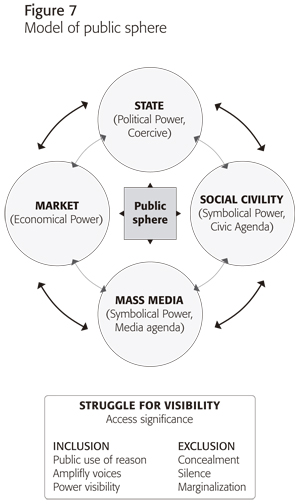
In this context, communicative citizenship tries to give more relevance, power and resources to civil society in the interaction of this actor with other institutions in the public sphere. At the same time, the six communicative citizenship dimensions have structural relations with the State, the market and the mass media, and the civil society has the opportunity to claim for these actors' specific responsibilities in the struggle for symbolical, political and economical power. From a field theory approach (Pierre Bourdieu), my argument is that the exercise of communicative citizenship and its dimension in the public spheres could transform and reconfigure the position of civil society in specific socio-historical fields. If the final aim of this concept is to provide communicative agency to citizens and to encourage a more active participation of citizens in the construction of their communicative and symbolic regimes, this is a good opportunity for them.
Moreover, the exercise of this communicative citizenship tries to affect two dynamics: on the one hand, to break the homogeneous concept of public sphere into a heterogenic concept of public spheres, in other words, to recognize a central public sphere, the social space where the official language reproduces its issues, topics and arguments and is more legitimized in the society, but, at the same time, to recognize minority public spheres, social power thematic spaces that overcome the central public sphere and configure other types of narratives, actors, structures and dynamics that affect specific areas (Bonilla 2003). On the other hand, to analyze the formation of communicative processes, structures and regimes in Western society, and to discover on what scale and level democracy is affected by this process. The next figure describes the relationship between public sphere and communicative citizenship model.
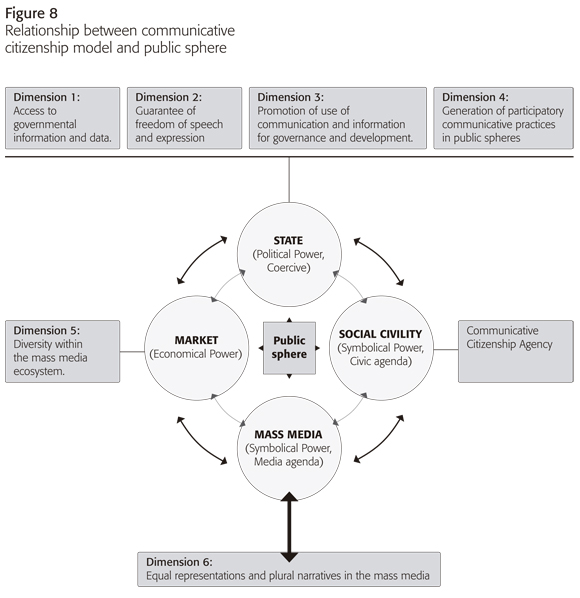
Figure 8 describes the ideal instrumentaliza-tion of the exercise of communicative citizenship in the public sphere. Civil society promotes communicative citizenship agency in citizens and, at the same time, the citizens improve the quality of this social institution, in a two way process. The six communicative citizenship dimensions have specific ties with other institutions like the State, the market and the mass media, in the theoretical framework of liberal societies, and form the base from which to demand rights, duties and responsibilities from these other actors for the benefit of civil society. This public sphere has different spatial references: face-to-face, mediated and virtual, and different geographical dimensions: local, national, regional and global. The communicative citizenship agency involves instruments, actions and processes to reconfigure the communicative resources of these social actors in the demand of communicative rights.
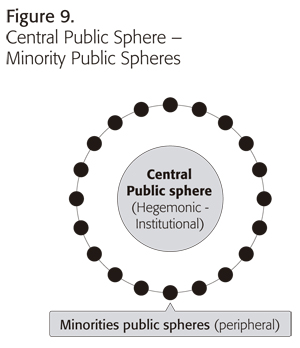
To sum up this part, two theoretical considerations: firstly, the purpose of this model is to give more power to citizens to exercise and demand rights in other ways, in this case communicative ways, amplifying the set of strategies, tactics and resources, and improving the quality of democracy in Western countries from a civil approach. Secondly, the socio-historical context determines the specific conditions of the exercise of this type of citizenship, and analyzing social structures and the development of this particular agency in these fields, is one of thefinal aims of this paper. In other words, the question: what type of socio-communicative regime allows the developing of what kind of communicative citizenship experience and vice versa? is crucial in this exercise, because the public sphere is a space in dispute and confrontation, and the category of power is a determinant in this process.
Communicative citizenship methodological box
In this final part, I am going to present a methodological tool to explore how this category could be analyzed and to find the trends of communicative citizenship in different contexts. This methodological tool combines quantitative methods and qualitative methods to develop a hermeneutic interpretation (Bryman 2008) and has three steps: firstly, triangulation, using qualitative research to corroborate quantitative research findings; secondly,facilitation, because one research strategy is employed in order to aid research using the other research strategy; and finally, complementary, using two research strategies in order that different aspects of an investigation can be dovetailed. Furthermore, this methodology has four phases: a literature review, a secondary analysis of quantitative data, a qualitative approach and a hermeneutic interpretation. The final methodological aim is to understand the different communicative regimes in different contexts, levels and scales, and how the communicative citizenship operates in this communicative regime.
First phase: literature review
The first phase is to develop a literature review of the particular context where the communicative citizenship category operates. The aim of this literature review is to find out the socio-historical conditions of one specific territory, and the historical trends of the relationship between citizenship, rights, democracy and communication. In other words, to develop a deep context of the particular place that is to be analyzed.
Second phase: quantitative data
The next step is to build quantitative data to examine how the six communicative citizenship dimensions operate in particular contexts. In some cases it is possible to do a secondary analysis of quantitative data, because some organizations, Governments, NGOs, universities or think thanks develop specific and useful approaches to this dimension; but, in ideal cases, to conduct independent research is pertinent. The next table shows the communicative citizenship dimensions and their quantitative category:
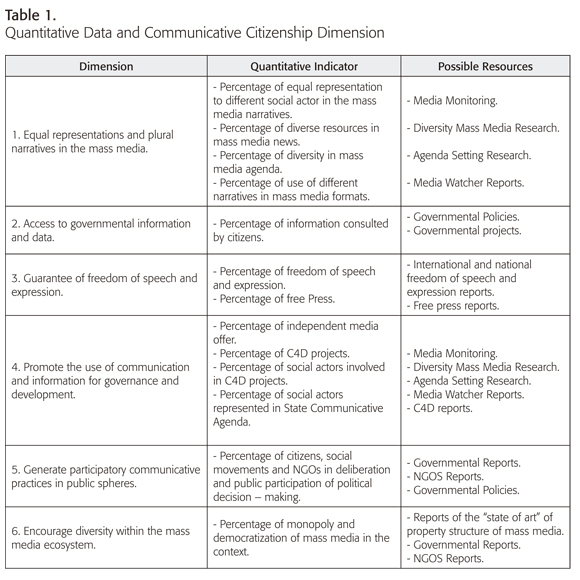
Third phase: qualitative approach
The next phase is to conduct a qualitative approach in three steps: firstly, indentify important social actors in the quantitative phase, and do a set of interviews with these actors and explore reasons, explanations and arguments of the quantitative results. Secondly, identify relevant social actors in specific positions of power to discover their opinion about the quantitative results; and thirdly, a set of interviews to people engaged with counter publics and social movements to figure out their positions on topic.
Four phase:
hermeneutic interpretation Finally, with the quantitative and qualitative information to develop an interpretation of these results, to respond to the principal questions of this research: what type of socio-communicative regime it is possible to establish in this context? What kind of communicative citizenship experience it is possible to identify in this context? What type of socio-communicative regime allows the developing of what kind of communicative citizenship experience and vice versa in this context?
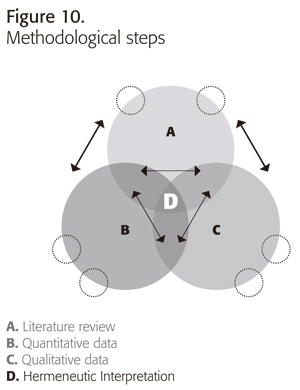
Conclusion
In this paper I described the relationship between communication, citizenship and rights and the five contemporary interconnections between citizenship and communication as well, focusing on two in more detail: on the one hand, the urgent need for a new set of rights, especially communicative rights, to provide other ways of understanding the role of communication in the public sphere and how this new role transforms traditional meanings of concepts like democracy, representation, rights, duties, responsibilities and participation in contemporary social structures. On the other hand, how this relationship provides new ideas to rethink the possibility of a better democratic media system and how this new socio-communicative regime could help to understand the central role of communication in contemporary society.
Furthermore, in this paper I argued that the traditional concept of citizenship is in crisis and now it is possible to find other types of citizenship experiences, identifications and citizenship dimensions, creating linkages with other social experiences, transnational practices, information flows, political identities and subjective recognitions. Moreover, in this work I described the political communication field, the social communication field and the cultural communication field, providing the principal discussions, approaches and main debates of the relationship between citizenship and the communicative dimensions of political, social and cultural rights.
In this context, it is important to remember that one of my principal arguments was that there is an urgent need to create a new concept or category to develop another approach to the rights, responsibilities and duties in connection with this new set of citizenship experiences, especially from the communication field, that affect other social categories like identity, ethnicity and power. If in the last decades the category of citizenship has focused on creating, or revalidating, a bond with civil, political, social and cultural rights, it is now relevant to consider other sets of rights and duties to understand the development of the current social structure and the new communicative regime. If the new social dynamic has a strong tie with communicative transformations, what kind of new citizenship experiences are emerging where the focus and centrality is the communicative process itself? What kind of new rights, responsibilities and duties is it possible to reconfigure? Could the triad "communicative regime - democracy - public sphere" be the clue to understanding the contemporary socio-communicative world in a citizenship approach? Is it possible to argue that the twenty first century is the era of communicative rights?
For these reasons, in this paper I explore in holistic terms this relationship between citizenship and the communicative dimensions of rights, creating the category, model and methodological box of the communicative citizenship concept to provide a more comprehensive approach to this field. In summary, the communicative dimensions of citizenship need to break the boundaries of the static categories of political, cultural and social rights to introduce more complex social relations, and start to think of the centrality of communicative rights as an independent and central category. This effort tried to overcome the limitations brought about by considering communicative rights in speciic ields only and the limitations in the comprehension, analysis and research of the socio-communicative field in society and its links with contemporary social science studies.
References
Alexander, J. (2006), The Civil Sphere, Oxford, Oxford University Press. [ Links ]
Barendt, E. (2005), Freedom of speech, 2nd ed, Oxford, Oxford University Press. [ Links ]
Bauman, Z. (1998), Globalization: the human consequences, New York, Columbia University Press. [ Links ]
__. (2007), Liquid times. Living in an Age of Uncertainty, Cambridge, Polity Press. [ Links ]
Beatson, J. & Cripps, Y. (2000), Freedom of expression and freedom of information: essays in honour of Sir David Williams, Oxford, Oxford University Press. [ Links ]
Beck, U. (2000), What is Globalization?, Cambridge, Polity Press. [ Links ]
Beck, U. (2002), "The cosmopolitan perspective: Sociology in the Second Age of Modernity", in Vertovec, S. & Cohen, R. (Eds), Conceiving Cosmopolitanism, Oxford, Oxford University Press, pp. 61-85. [ Links ]
Bennett, W. & Entman, R. (2001), Mediated Politics. Communication and the Future of Democracy, Cambridge, Cambridge University Press. [ Links ]
Benhabib, S. (1992), "Models of Public Space", in Calhoun, C. (Ed.), Habermas and the Public Sphere, Cambridge Mass, MIT press, pp. 75-97. [ Links ]
Bonilla, J. (2003), Presentación transformaciones de lo público, reinvención de la opinión. Modulo Diplomado Periodismo Público, Pontificia Universidad Javeriana - Medios para la Paz, Bogotá. [ Links ]
__. (2004), "Medios de comunicación, opinión pública y conflicto armado: el consenso por otras vías", in Síntesis: Anuario social, político y económico de Colombia, Bogotá, Nueva Sociedad, pp. 3 - 9. [ Links ]
Bryman, A. (2008), Social Research Methods, Third edition, Oxford, Oxford University Press. [ Links ]
Calhoun, C. (1992), Habermas and the Public Sphere, Cambridge Mass, MIT press. [ Links ]
Castells, M. (1997), The Power of Identity, Oxford, Blackwell. [ Links ]
__. (2006), La sociedad red: una vision global, Madrid, Alianza Editorial. [ Links ]
Clark, N. (1998), The new political culture, Boulder, Westview press. [ Links ]
Couldry, N. & Curran, J. (2003), Contesting Media Power. Alternative Media in a Networked Lanham, Maryland, Rowman and Littlefield. [ Links ]
Croucher, S. (2004), Globalization and Belonging: The politics of Identity in a Changing World, Lanham, ML, Rowman & Littlefield. [ Links ]
Curran, J. (1997), "Rethinking the media as a public sphere", in Dahlgren, P. & Sparks, C. (eds), Communication and Citizenship: Journalism and the public sphere, London, Routledge, pp. 27-57 [ Links ]
Curran, J. (2005), Mediations of Democracy. In Curran, J & Gurevitch, M (eds). Mass Media and Society. London: Hodder Arnold, pp. 122-152. [ Links ]
Curran, J., & Morley, D. (2006), Media and Cultural Theory, Abingdon, Routledge. [ Links ]
Curran, J., Iyengar, S., Anker, B. & Inka, S. (2009), "Media System, Public Knowledge and Democracy: A Comparative Study", European Journal of Communication, 24 (1), pp. 5-26. [ Links ]
Dahlgren, P. (2001), "The Public Sphere and the Net: Structure, Space and Communication", in Bennett, W. & Entman, R. (Eds), Mediated Politics. Communication in the Future of Democracy, Cambridge, Cambridge University Press. [ Links ]
Dobson, A. (2004), Ecological Citizenship, Paper presented at the annual meeting of the Western Political Science Association, Marriott Hotel, Portland, Oregon. [ Links ]
Fraser, N. (1990), "Rethinking the Public Sphere: A Contribution to the Critique of Actually Existing Democracy", in Social Text, No 25, Duke University Press, pp. 56-80. [ Links ]
Gumucio-Dagron, A. & Tufte, T. (2006), Communication for Social Change Anthology: Historical and Contemporary Readings, South Orange, NJ, Communication For Social Change Consortium. [ Links ]
Habermas, J. (1962), Strukturwandel der Öffentlichkeit. Untersuchungen zu einer Kategorie der bürgerlichen Gesellschaft. (English translation in 1989 by Thomas Burger and Frederick Lawrence: The Structural Transformation of the Public Sphere: An Inquiry into a category of Bourgeois Society), Cambridge, Polity. [ Links ]
Hancock, G & Mueller, R. (2010), The reviewer's guide to quantitative methods in the social sciences, London, Routledge. [ Links ]
Hackett, R & Carroll, W. (2006), Remarking Media. The struggle to democratize public communication, Abingdon, Routledge. [ Links ]
Hauser, G. (1999), Vernacular Voices: The Rhetoric of Publics and Public Spheres, Columbia, University of South Carolina Press. [ Links ]
Held, D. (2004), Global Covenant, Cambridge, Polity Press. [ Links ]
Hermes, J. (2008), "Citizenship in the Age of the Internet", European Journal of Communication, vol. 21, no. 3, pp 295-309. [ Links ]
Hesmondhalgh, D, & Toynbee, J. (2008), The media and social theory, Abingdon, Routledge. [ Links ]
Hesmondhalgh, D & Toynbee, J. (2008), "Why media studies needs better social theory", in Hesmondhalgh, D. & Toynbee, J. (Eds), The media and social theory, Abingdon: Routledge, pp. 1-24 [ Links ]
Karppinen, K. (2008), "Media and the paradoxes of pluralism", in Hesmondhalgh, D. & Toynbee, J. (Eds), The media and social theory, Abingdon, Routledge, pp. 27-42. [ Links ]
Klang, M. & Murray, A. (2005), Human rights in the digital age, London, GlassHouse Press. [ Links ]
Marshall, T.H. (1992), "The Problem Stated with the Assistance of Alfred Marshall" (originally delivered in 1949), in Marshall, T.H. & Bottomore, Citizenship and Social Class, London, Pluto Perspectives, pp. 3-51. [ Links ]
Martin-Barbero, J. (1993), Communication, Culture and Hegemony: From the media to mediations, London, Sage. [ Links ]
Mcloughlin, C & Scott, Z. (2010). Topic Guide on Communications and Governance, Birmingham, The Communication for Governance and Accountability Program (CommGAP). [ Links ]
McNair, B. (1999), An introduction to political communication, London, Routledge. [ Links ]
McPhail, T. (2009), Development Communication: Reviewing and Reframing, London, Wiley/Blackwell. [ Links ]
Medina, G. & García, W. (2001), "Estado del arte de los estudios sobre comunicación y violencia", in Angarita, P. (Ed), Balance de los estudios sobre violencia en Antioquia (pp. 331-360), Medellín, Universidad de Antioquia. [ Links ]
Meikle, G. (2004), "Networks of Influence: Internet Activism in Australia and Beyond", in Goggin, G. (Ed), The Internet in Australia, Sydney, University of New South Wales Press. [ Links ]
Mouffe, C. (1992), Dimensions of Radical Democracy: Pluralism, Citizenship, Community, London - New York, Verso. [ Links ]
__. (2000), The Democratic Paradox, London, Verso. [ Links ]
Negri, A. & Hardt, M. (2004), Multitude: war and democracy in the age of Empire, New York, The Penguin Press. [ Links ]
Negt, O & Kluge, A. (1993), Public sphere and experience: toward an analysis of the bourgeois and proletarian public sphere, Minneapolis, University of Minnesota Press. [ Links ]
Plummer, K. (2003), Intimate Citizenship: Private Decisions and Public Dialogues, Seattle, University of Washington Press [ Links ]
Pruitt, B. & Thomas, P. (2007), Democratic Dialogue: A Handbookfor Practitioners, New York, United Nations Development Program Press. [ Links ]
Rey, G. (2007), La fuga del mundo. Escritos sobre periodismo, Bogotá, Debate. [ Links ]
Sassen, S. (2007), Una sociología de la globalización, Barcelona, Katz. [ Links ]
Siochrú, O. (2005), Assessing Communication Rights: A Handbook,, London, CRIS Campaign. [ Links ]
Stevenson, N. (2002), Cosmopolitanism, Multiculturalism and Citizenship. Sociological Research Online, Vol 7, No 1, Retrieved May 18, 2010, from http://www.socresonline.org.uk/7 /i /stevenson.html [ Links ]
Stevenson, N. (2003), Cultural citizenship: cosmopolitan questions, Berkshire, Open University Press. [ Links ]
Tilly, C. (1995), Popular Contention in Great Britain, 1758-1834, Cambridge, Harvard University Press. [ Links ]
Todorov, T. (1999), "Comunicación y verdad", in Comte-Sponville A. & Ferry L., La sabiduría de los modernos", Barcelona, Editorial Península. [ Links ]
United Nations (1997), Communication for development programmes in the United Nations System, Resolution adopted by the General Assembly, New York, United Nations Press. [ Links ]
Vertovec, S. (2009), Transnationalism. Abingdon, Routledge. [ Links ]
Voltmer, K. (2006), Mass Media and Political Communication in New Democracies, London, Routledge. [ Links ]
Warner, M. (1992), "The Mass Public and the Mass Subject", in Calhoun, C. (Ed.), Habermas and the Public Sphere, Cambridge Mass, MIT press, pp. 377-401. [ Links ]
Wolfsfeld, G. (1997), Media and Political Conflict: News from the Middle East, Cambridge, Cambridge University Press. [ Links ]
Yip, A. (2008), "The quest for intimate/sexual citizenship: Lived experiences of lesbian and bisexual Muslim women", in Contemporary Islam, vol. 2, no. 2, pp. 99-117 [ Links ]














